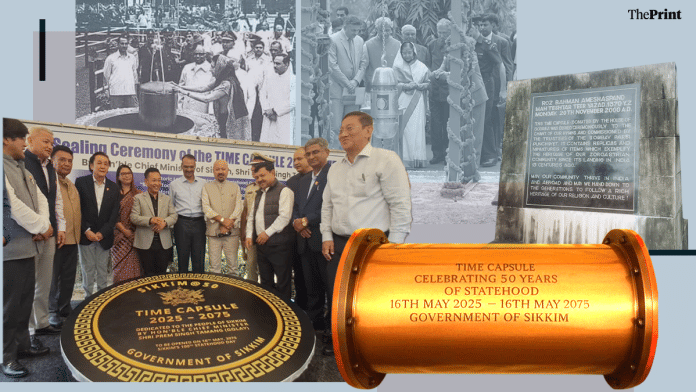New Delhi: Marking five decades of statehood, Sikkim has launched a time capsule as part of the information & public relations department’s project to preserve the state’s essence, including its culture, society, and development, for posterity.
It is not the first time India has seen a time capsule project. In 1972, then-Prime Minister of India Indira Gandhi buried a capsule, known as Kalpaatra, at the Red Fort in Delhi, to mark the 25th anniversary of India’s Independence.
That capsule, made of stainless steel, contained documents detailing India’s progress in the fields of science, technology, industry and politics, along with messages and records from the government, including a document of nearly 10,000 words. It lay buried 32 feet deep in the ground, supposedly to be dug out, only after 1,000 years.
However, it became a matter of political controversy, with critics saying it is a selective portrayal of history. Eventually, it was unearthed and removed in 1977 during the time of the Janata Party government. According to media reports, the contents of the capsule were later made available in the Parliament library for members to inspect.
A time capsule is a container that contains documents, photos, letters, and artefacts for future generations to unearth and discover. The capsule’s working mechanism ensures the contents inside do not decay over time, even if pulled out after a century.
According to the database available with the International Time Capsule Society (ITCS), there are “10,000-15,000 time capsules worldwide”.
Besides the time capsule that Indira Gandhi buried and that now is in the Parliament library, India has several time capsules, including one at a school in Mumbai, another at the Indian Institute of Technology-Kanpur, a third at Lovely Professional University in Jalandhar, and a fourth at the Mahatma Mandir in Gandhinagar.
Ahead of the Ram Temple foundation ceremony in Ayodhya in 2020, contradictory statements on a proposed time capsule created confusion. Trust member Kameshwar Chaupal claimed that a time capsule is going to contain messages on Ayodhya, Lord Ram, and his birthplace, and then, preserved to last thousands of years. However, general secretary Champat Rai denied any such plan.
Sikkim time capsule 2025-2075
Now, Sikkim has created its time capsule to celebrate a milestone in its statehood. On 21 August, Chief Minister of Sikkim Prem Singh Tamang buried the capsule at Rustomji Deer Park, Gangtok, within the state secretariat at Tashiling.
Calling it a “landmark moment” in the state’s history, Tamang said the capsule will serve as a “gift of memory”, as well as a reminder of the state’s journey over the past 50 years.
Set to be opened at a 26 May 2075 event, when Sikkim will celebrate a century of statehood, the capsule aims to symbolise the Himalayan state’s legacy, as well as its transformation over the years.
It contains messages and letters from leaders, citizens, and handwritten notes from the current Chief Minister and Governor, as well as schoolchildren. A rose-coloured cylinder, made from surgical-grade stainless steel, weighing 32 kilograms, houses the contents.
To preserve the capsule contents, designers used oxygen absorbers and silica gel to prevent biological degradation. Moreover, a prototype of the capsule will be at the famous MG Marg in Gangtok for public viewing.
At least 534 individuals, including students and employees from schools, colleges, and state departments, contributed materials. Special paper and ink, designed to withstand the test of time, were used to ensure the records remained intact.
“The government plans to open the capsule in 2075, that is, after another 50 years,” said Tamang, emphasising it will keep alive the state’s customs, traditions, and the names of its people for future generations.
Tamang, along with Governor Om Prakash Mathur, formally launched the project on 16 May this year during the statehood day celebrations.
(Edited by Madhurita Goswami)
Also Read: Mizoram, Tripura, Nagaland districts top performers in North-East SDG Index, but challenges remain






